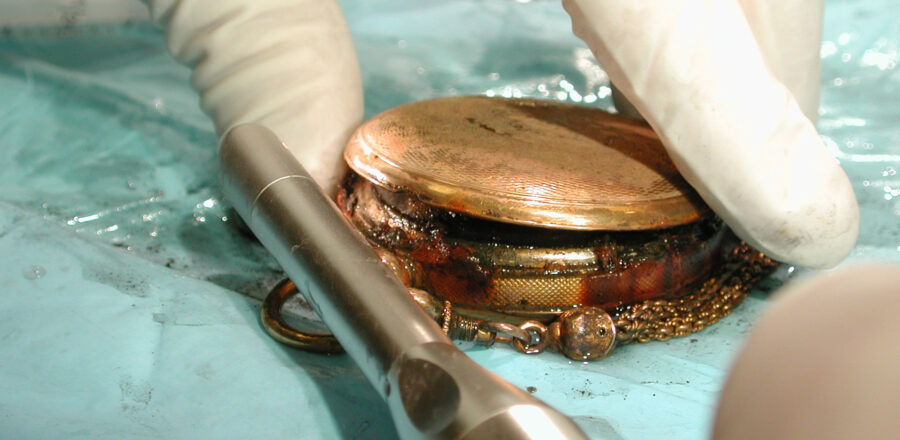FOR IMMEDIATE RELEASE ** May 26th 2022 **
Video Press Release at: https://www.dropbox.com/s/id7trkkfr2laqfz/hunley__watch_discoveryVIDEO.mp4?dl=0
Photos at: https://www.dropbox.com/sh/svhyl5vn05filyy/AACH3R2ULjKi2ShQo1PWCPDsa?dl=0
The Hunley became the world’s first successful combat submarine in 1864 and then vanished into the sea. Lost for over a century, the submarine was found in 1995 and raised from the ocean floor in 2000. She proved to be a time capsule holding a wide-array of 19th-century artifacts.
During excavation of the crew compartment, perhaps one of the most intriguing finds was a gold pocket watch. It was found nestled in the remains and deteriorated remnants of Captain Dixon’s vest. Researchers are hopeful the watch holds a valuable clue to helping solve the mystery of the Hunley’s disappearance. This weekend the elegant and mysterious artifact will go on permanent public display for visitors to the Hunley lab as part of their Treasures of the Past Exhibit.
“The watch truly is a rare and exciting archaeological find. We are still conducting research to try to fully understand what it can teach us about the night the Hunley was lost,” said Clemson University Archaeologist Nicholas DeLong.
HOW LONG DID THE HUNLEY CREW SURVIVE?
The watch could help answer a lingering mystery: how long did the crew survive after the sinking of the USS Housatonic? If Dixon set his timepiece accurately before entering the submarine, the watch represents the first opportunity to place a timeline on events that transpired the night of the attack.
It would have stopped working if it was wet or suffered a hard blow so the time displayed on the watch would likely be frozen near the moment those events occurred. Most survivors of the history-making attack say it occurred between 8.45 – 9.00 pm.
When scientists carefully opened the watch, they were surprised to find the crystal cover was completely intact and not even cracked. The hands on the watch showed 8.23.
This puzzled scientists. That is at least twenty minutes before witnesses say the Hunley attacked. There are many possible reasons for the discrepancy:
Only time, and more research, will tell what the watch can teach us.
SAVING THE WATCH
The watch was worth a substantial amount of money but also important to navigating the submarine. It would have helped the crew time their mission to ride the tide out and back to land without having to propel the hand-cranked vessel against the currents. This golden artifact’s history is as amazing as its conservation was challenging.
“I have been part of the team on hundreds of artifact conservation efforts. This one stands out as one of the most difficult but also the most rewarding,” said Clemson University Conservator Johanna Rivera.
A detailed x-ray analysis was conducted before the artifact was touched. The watch’s gold casing was relatively easy to stabilize. But its internal movement and time display were a different story. They are made of a variety of materials — including steel, paint, porcelain, and brass — all of which required different and very specific conservation treatments.
Given the complexity of the watch’s design, conservators decided the best approach was to delicately disassemble it for treatment. Many of the components were conserved separately before being re-assembled with extraordinary precision.
Thanks to Hunley conservators, Dixon’s elegant watch is a beautifully preserved artifact that will survive for generations to come.
The Hunley Project (www.hunley.org)
On the evening of February 17, 1864, the H. L. Hunley became the world’s first successful combat submarine by sinking the USS Housatonic. After signaling to shore the mission had been accomplished, the submarine and her crew of eight mysteriously vanished. Lost at sea for over a century, the Hunley was located in 1995 by Clive Cussler’s National Underwater and Marine Agency (NUMA). The innovative vessel was raised in 2000 and delivered to the Warren Lasch Conservation Center, where an international team of scientists are at work to conserve the submarine for future generations and piece together clues to solve the mystery of her disappearance. The final goal of the project is to support the creation of a maritime museum to house one of the nation’s most comprehensive naval collections and tell the fascinating story of America’s history at sea. The Hunley Project is conducted through a partnership with the Charleston Naval Complex Redevelopment/Naval Base Museum Authority, Clemson University Restoration Institute, Friends of the Hunley, Naval History and Heritage Command, and South Carolina Hunley Commission.


